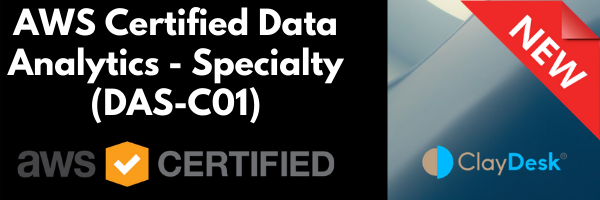About Course
AWS Certified Data Analytics – Specialty (DAS-C01) Course. It was formerly known as AWS Certified Big Data – Specialty

In addition, the AWS Certified Data Analytics – Specialty (DAS-C01) Course has two important updates. The certification will have a new name, AWS Certified Data Analytics – Specialty, along with an updated exam version.
Why the name change? After all, Data Analytics and Big Data represent a rapidly changing field. The term “data analytics” more closely aligns with language we hear from our customers and our AWS offerings. Therefore, AWS changed the name of the certification in response.
The AWS Certified Data Analytics – Specialty certification validates expertise working with AWS services to design, build, secure, and maintain analytics solutions. As a result, you will be able to grow your career and earn six figure salary.
Furthermore, AWS Certified Data Analytics – Specialty (DAS-C01) Course exam validates an examinee’s ability to:
Define AWS data analytics services and understand how they integrate with each other.
Explain how AWS data analytics services fit in the data lifecycle of collection, storage, processing, and visualization.
Recommended AWS Knowledge
A minimum of 5 years of experience with common data analytics technologies, and at least 2 years of hands-on experience working on AWS
Experience and expertise working with AWS services to design, build, secure, and maintain analytics solutions
Content Outline
Subsequently, this exam guide includes weightings, test domains, and objectives only. Thus, it is not a comprehensive listing of the content on this examination. Therefore, the table below lists the main content domains and their weightings.
1: Collection 18%
2: Storage and Data Management 22%
3: Processing 24%
4: Analysis and Visualization 18%
5: Security 18%
TOTAL 100%
In addition, the exam guide includes weightings, test domains, and objectives only. It is not a comprehensive listing of the content on this examination. The table below lists the main content domains and their weightings.
Domain 1: Collection
1.1 Determine the operational characteristics of the collection system
1.2 In addition, select a collection system that handles the frequency, volume, and source of data
1.3 Select a collection system that addresses the key properties of data, such as order, format, and compression
Domain 2: Storage and Data Management
2.1 Determine the operational characteristics of a storage solution for analytics
2.2 In addition, determine data access and retrieval patterns
2.3 Also, select an appropriate data layout, schema, structure, and format
2.4 Define a data lifecycle based on usage patterns and business requirements
2.5 Also, determine an appropriate system for cataloging data and managing metadata
Domain 3: Processing
3.1 Determine appropriate data processing solution requirements
3.2 Also, design a solution for transforming and preparing data for analysis
3.3 In addition, automate and operationalize a data processing solution
Domain 4: Analysis and Visualization
4.1 Determine the operational characteristics of an analysis and visualization solution
4.2 Also, select the appropriate data analysis solution for a given scenario
4.3 Select the appropriate data visualization solution for a given scenario
Domain 5: Security
5.1 Select appropriate authentication and authorization mechanisms
5.2 Also, apply data protection and encryption techniques
5.3 Apply data governance and compliance controls

Course Content
Introduction
-
03:02
-
07:52
-
Sample Exam Question and Solution
08:34
